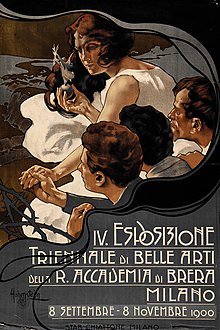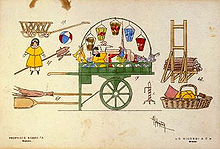This article includes a list of general references, but it lacks sufficient corresponding inline citations. (October 2021) |
Adolfo Hohenstein | |
|---|---|
 Hohenstein with his wife Edwig in 1905 | |
| Born | 18 March 1854 |
| Died | 12 April 1928 (aged 74) Bonn, Germany |
| Nationality | German |
| Known for | Painting, Illustration, Decorative art |
| Notable work | Tosca and La Bohème posters, Campari ads |
| Movement | Art Nouveau, called Stile Liberty in Italy |
Adolfo Hohenstein (18 March 1854 – 12 April 1928) was a German painter, advertiser, illustrator, set designer and costume designer. Hohenstein is considered the father of Italian poster art [citation needed] and an exponent of the Stile Liberty, the Italian Art Nouveau. Together with Leonetto Cappiello, Giovanni Mario Mataloni, Leopoldo Metlicovitz and Marcello Dudovich, he is considered one of the most important Italian poster designers [citation needed].
Early years
[edit]






Adolfo Hohenstein was born in Saint Petersburg, the capital of Russian Empire, to German parents, Julius and Laura Irack. His father was a forest engineer, whose career prompted him to travel extensively. Adolfo moved to Vienna where he grew up and completed his studies. His travels took him to India, where he decorated the houses of the local nobility.
The Italian experience
[edit]In 1879, he settled down in Milan, Italy. He became a set and costume designer for La Scala and other theatres. There he met the musical publisher Giulio Ricordi, and in 1889 began to work for the Ricordi Graphical Workshops, where he shortly became the artistic director in charge of the graphical part. He created the posters for La Bohème and Tosca, as well as publicity for Campari, Buitoni and Corriere della Sera, numerous postcards, covers for scores and booklets. His work continued to cover the theatrical dimension: scenarios and wardrobes for several works, among them Giuseppe Verdi's Falstaff (1893) and a major part of the works of Giacomo Puccini, from the sketches of Le Villi (1884) to posters of Madama Butterfly (1904). At Ricordi's he had as colleague Giovanni Mario Mataloni and as students Leopoldo Metlicovitz and Marcello Dudovich.
Return to Germany
[edit]In the first years of the 1900s, after marrying Katharina Plaskuda, a widow, he traveled more and more frequently between Italy and Germany till 1906, when, after winning the competition for the graphical symbol and the poster for the "Esposizione per il Traforo del Sempione", he left Milan for Bonn and Düsseldorf definitively. He settled in Bonn in 1918. The German years saw him engaged mostly as a painter and involved in the decoration of numerous buildings, among them one of the first in constructed reinforced concrete in Renania (1911). He is associated with the Düsseldorf school of painting.
Adolfo Hohenstein died in Bonn 12 April 1928.
Main poster works
[edit]- 1898 – Corriere della Sera
- 1898 – Cintura Calliano contro il mal di mare
- 1899 – Onoranze a Volta nel centenario della pila
- 1899 – Cesare Urtis & Co. Torino. Forniture electriche
- 1900 – Esposizione d'Igiene
- 1900 – Monte Carlo. Tir aux pigeons
- 1900 – Monaco. Exposition et concours de canots automobiles
- 1901 – Bitter Campari
- 1905 – Fiammiferi senza fosforo del Dottor Craveri
- 1906 – Birra Italia
Main theatre works (Ricordi Archives)
[edit]

- Giacomo Puccini, Le Villi, Milan, Teatro Dal Verme, 31 May 1884
- 2 original sketches
- 2 scenario props
- Giacomo Puccini, Edgar, Milan, Teatro alla Scala, 21 April 1889
- 54 original costumes
- 5 scenario props
- Richard Wagner, Mastersingers of Nuremberg, Milan, Teatro alla Scala, 26 December 1889
- 62 original costumes
- 4 set props
- Alfredo Catalani, Loreley, Torino, Teatro Regio, 16 February 1890
- 42 original costumes
- Alfredo Catalani, La Wally, Milan, Teatro alla Scala, 20 January 1892
- 4 original sketches
- 41 original costumes
- 1 set prop
- Alberto Franchetti, Cristoforo Colombo, Milan, Teatro alla Scala, 26 January 1892
- 90 figurini originali
- Niccolò van Westerhout, Cimbelino, Rome, Teatro Argentina, 7 April 1892
- 37 original costumes
- 3 set props
- Giacomo Puccini, Manon Lescaut, Torino, Teatro Regio, 1893
- 57 original costumes
- 4 set props
- Giuseppe Verdi, Falstaff, Milan, Teatro alla Scala, 9 February 1893
- 5 original sketches
- 41 original costumes
- 4 set props
- 13 watercolor designs
- Giacomo Puccini, La Bohème, Torino, Teatro Regio, 1 February 1896
- 3 original sketches
- 62 original costumes
- 4 set props
- Pietro Mascagni, Iris, Rome, Teatro Costanzi, 22 November 1898
- 3 original sketches
- 40 original costumes
- 9 set props
- 1 portrait of Mascagni
- Giacomo Puccini, Tosca, Rome, Teatro Costanzi, 14 January 1900
- 3 original sketches
- 49 original costumes
- 4 set props
- Alberto Franchetti, Germania, Milan, Teatro alla Scala, 1 March 1902
- 4 original sketches
- 95 original costumes
- 7 set props
- Franco Alfano, Risurrezione, Torino, Teatro Regio, 1904
- 2 set props
Exhibitions
[edit]- 1894 – Esposizioni Riunite, Milan, Biblioteca Nazionale Braidense
- 1911 – Katalog der Großen Kunstausstellung Düsseldorf (27 May – 8 October), Düsseldorf, Kunstpalast
- 1912 – Katalog der Frühjahrs-Ausstellung (3 March – 14 April), Düsseldorf, Kunstpalast
- 1916 – Kunstchronik, Neue Folge 26, Munich, Zentralinstitut für Kunstgeschichte
- 1917 – Große Berliner Kunstausstellung, Düsseldorf, Kunstpalast (16 June – 30 September): one oil painting, Schwarzwaldküche (Black Forest kitchen)[1]
See also
[edit]References
[edit]- ^ Große Berliner Kunstausstellung 1917 im Kunstpalast zu Düsseldorf (in German). Berlin: Verlag der Otto Elsner Akt.-Ges. 1917. Catalogue no. 968. Digital copy of Heidelberg University Library
Bibliography
[edit]- Dizionario Enciclopedico Bolaffi dei Pittori e degli Incisori Italiani – dall'XI al XX secolo (volume VI). Giulio Bolaffi Editore, Torino, 1974.
- Un secolo di manifesti. Canova-Alberto Maioli Editore, Milano, 1996. ISBN 88-87843-10-4.
- Edigeo (a cura di). Enciclopedia dell'arte Zanichelli. Zanichelli, Bologna, 2004. ISBN 88-08-22390-6.
- Giorgio Fioravanti. Il dizionario del grafico. Zanichelli, Bologna, 1993. ISBN 88-08-14116-0
External links
[edit]- 2003 Treviso retrospective (in Italian)